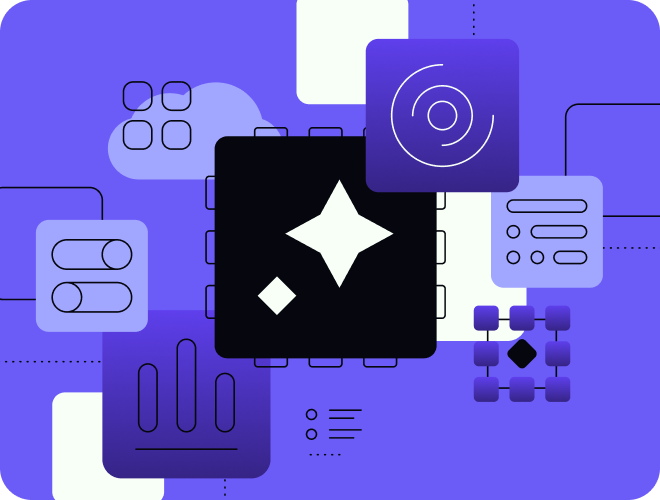No Code vs Full Code Software Development: What is The Difference?


.avif)
Subscribe to our Newsletter
What’s the best way to build your next software project?
The decision between no code vs full code can influence everything from your development speed and costs to how much control you have. For startups trying to launch quickly, or enterprises building complex systems, understanding both methods is key.
This guide breaks down the strengths and trade-offs of each approach.
You’ll see how they compare across flexibility, learning curve, pricing, customization, and timelines.
By the end, you’ll be better equipped to choose a path that matches your goals, whether you need to move quickly or build something fully customized.
What is No-Code Software Development?
No-code development allows users to build software without writing traditional code. Instead of typing syntax, users interact with visual interfaces like drag-and-drop tools to design workflows, configure databases, and publish applications.
This technique lowers the barrier to entry for non-technical users, making it easier for teams across departments, not just engineers, to participate in software projects.
Most no-code platforms offer pre-built components, templates, and automation features that simplify everyday business tasks such as dashboard creation, internal tool development, or form-based workflows.

These tools speed up the development process and reduce bottlenecks often caused by limited technical resources by removing the need for coding knowledge.
No-code solutions work well for projects that need a fast turnaround without sacrificing usability. While they have limitations, they’re especially helpful for startups, small businesses, and internal teams trying to launch without a large team of professional developers.
To get started, review some of the best free Bubble templates for no-code projects, which can speed up prototyping and reduce friction.
What is Full Code Software Development?
Full-code development means building software by writing every component using programming languages. Unlike no-code platforms, which rely on visual tools, full-code requires developers to construct the application from the ground up, handling logic, architecture, integrations, and user experience manually.
Full-code gives experienced developers complete control to define how an app behaves, scales, and interacts with other systems. It’s often the preferred choice for projects that require custom features, advanced workflows, or rigorous compliance standards.
Because every detail is crafted through code, the result is typically more flexible, more scalable, and better aligned with long-term business goals. However, this also makes it slower to deliver and more resource-intensive.
Teams need coding expertise, robust testing practices, and a deep understanding of the software development lifecycle (SDLC).
The trade-off? Tailored functionality and independence from third-party no-code tools.
While slower than low-code platforms, this method suits companies building complex systems or preparing for large-scale growth.
Traditional Development vs No-Code Development. Main Distinctions

How Long Each Approach Takes to Build a Product
Speed is a key differentiator in the no-code vs full-code debate.
With no code development, teams can design workflows, structure data, and publish working applications in days, not months. No code tools eliminate the need for syntax, which accelerates delivery for business users and non-specialists.
In contrast, traditional development requires time-intensive coding, debugging, and testing.
Each step must be done by professionals with strong coding knowledge, which increases delivery timelines, especially for large-scale systems or custom features.
Still, when deadlines are flexible and precision is critical, code development is often the better fit. Curious how long projects actually take? We break it down in how long does it take to build an app?.
How Easy It Is to Learn and Use the Tools
No code platforms prioritize accessibility.
Their drag and drop interfaces and visual interfaces allow teams to build functional tools without writing a line of code. This ease of use reduces onboarding time and expands who can contribute, from product managers to citizen developers.
Meanwhile, traditional coding requires fluency in programming languages and system design. Most software developers spend years mastering these skills.
If speed and accessibility are priorities, no-code development lowers the barrier. For projects requiring deep control or performance, traditional methods demand more time and training but offer unmatched flexibility.
How Much You Can Expect to Spend on Each Option
No-code platforms are often more cost-effective upfront.
Their subscription models allow teams to build solutions without hiring professional developers or investing in long timelines, making them appealing for MVPs, internal tools, or short-term needs.
Before estimating costs, explore how to make a budget for software development to avoid hidden expenses.
Full code development, however, involves hiring experienced developers, planning long sprints, and maintaining infrastructure. The total cost is higher, but it is often justified for complex systems that must scale, integrate deeply, or meet strict compliance needs.
Each model offers value; it depends on how much customization and longevity you’re prioritizing.
What You Can and Can’t Customize in Your App
Code platforms define the limits of what can be customized. With no code tools, you can adjust layouts, workflows, and logic, especially in tools built for business processes or mobile apps. But once you outgrow what the platform allows, hitting a wall is common.

By contrast, full code offers complete customization.
You can tailor features, design architecture, and control how the app behaves down to the smallest interaction. It takes longer but removes the ceilings common in low code platforms or no code software.
For advanced functionality or specific integrations, custom code wins. For advanced functionality or specific integrations, custom code wins, especially in complex use cases like enterprise app development.
What Skills Are Needed to Start Building
No code development eliminates the need for formal coding skills.
Anyone, from marketers to business users, can build functional software using drag and drop interfaces and visual workflows.
These tools abstract technical logic into intuitive actions, making it easier to launch projects without relying on IT professionals. Teams launching early-stage ideas should review the difference between an MVP vs prototype to prioritize the right development effort.
This opens the door for faster iteration across teams. With minimal training, individuals can build internal tools, dashboards, and even full web apps.
In contrast, full code development demands fluency in programming languages, system architecture, and debugging methods.
Projects usually require specialists with strong coding expertise and experience using low code tools or traditional IDEs. The learning curve is steep, which limits participation to trained developers.
Deciding which path fits best depends on available skills and how technical the project needs to be.
How Quickly You Can Launch a Prototype
Speed plays a central role in early-stage software efforts.
With no code development, teams can create prototypes in hours using drag and drop interfaces and visual interfaces. These tools reduce complexity, helping teams test ideas and user flows without needing coding knowledge or support from professional developers.
This makes it easier for business users or citizen developers to experiment and collect feedback, especially when time or fewer resources are available.
On the other hand, full code development gives technical teams the ability to craft prototypes with advanced custom code, tailored UI, and exact features. It’s more accurate, but also slower. Every piece must be written, tested, and reviewed, which stretches timelines.
The trade-off is clear: no code tools deliver speed for basic concepts, while full code offers accuracy for complex functionalities.
What Ongoing Maintenance Looks Like for Each Option
Maintenance is an essential part of the software development lifecycle.
With no code platforms, most upkeep is handled by the provider. Updates, security patches, and system upgrades happen automatically, freeing teams from managing technical maintenance. For business users or teams without coding expertise, this hands-off model reduces effort and lowers support demands.
That simplicity comes with trade-offs. You rely on external schedules, and some changes may be out of your control.
In contrast, full code development gives organizations full ownership.
The team manages every update, patch, and enhancement directly. This requires experienced or traditional developers, but it offers full visibility and immediate fixes when needed.
The choice depends on available resources and how much control you need over updates and issue resolution. No code solutions offer convenience, while custom code gives you complete oversight of ongoing system behavior.
Popular No Code Tools for Web and Mobile Apps
Modern no code platforms have changed how teams build software by removing traditional barriers. These tools offer visual interfaces, drag-and-drop editors, and pre-built modules, making it possible to create working products without writing code.
Want to build with Bubble? Read how to build a CRM with no-code for a real-world use case.
Some of the most widely used no code tools include:
- Bubble: A comprehensive no code app builder for web apps. Users can build both mobile apps and responsive websites using drag and drop interfaces.
- Zapier: A workflow automation tool that connects different apps and services, ideal for automating business processes with minimal effort.
- Airtable: Combines database functionality with spreadsheet usability—popular for teams managing complex data sets.
- Softr: Transforms Airtable data into web portals, directories, and client-facing apps with customizable design blocks.
- Glide: Great for building mobile apps directly from spreadsheets, ideal for fast prototyping and internal tools.
These no code development platforms support rapid application development while reducing the need for coding knowledge or technical staff.
For business users, this means faster turnaround times and fewer blockers when building internal tools, dashboards, or client apps, especially when time or budget is limited.
Benefits of No Code Software Development

No-code development opens the doors to speed, accessibility, and cost-efficiency. With no-code platforms, teams can bring software ideas to life without relying on traditional developers or deep coding expertise.
One key benefit is faster app development.
Projects that once took weeks can now launch in days. With drag and drop functionality, visual editors, and pre-built components, teams can move from idea to prototype with fewer bottlenecks. If you’re a startup building quickly, explore no-code development benefits for small businesses & startups.
Cost savings follow. Businesses avoid the overhead of hiring experienced developers and can instead easily build custom apps or internal tools using internal business users.
There’s also increased autonomy. Citizen developers, non-technical staff, can now participate in software creation, reducing dependency on IT and speeding up execution. This decentralization makes it easier to experiment and solve problems directly at the team level.
For many teams, the ability to launch quickly, test ideas, and make updates independently makes no code software a practical choice, especially for lightweight tools or internal-facing solutions.
Limitations of No Code Software Development
While no code development increases speed and accessibility, it’s not ideal for every situation.
The biggest limitation lies in customization. Most no code platforms rely on fixed templates and visual building blocks, which can restrict flexibility in complex projects. Businesses that need advanced software applications or features tied to niche workflows may find these tools too limiting.
When growth starts to strain your platform, consider the guidance on important factors to weigh when choosing a custom software development.
Scalability can also become a roadblock. As user volume or functionality grows, apps built with no code tools may struggle to adapt. Their architecture isn’t always equipped to handle increased load or specialized business processes.
Another concern is platform dependency.
Teams rely heavily on the provider’s infrastructure, which means limited control over updates, outages, or future pricing changes. If the platform folds, migrating your software development efforts can be time-consuming and expensive.
Finally, security and compliance present challenges. Industries with strict data regulations might need backend access or encryption options not offered by many code platforms.
These trade-offs don’t make no code unusable, but they do call for careful evaluation, especially when the goal is long-term, large-scale product success.
Benefits of Full Code Software Development
Full code development gives teams unmatched control over how software behaves, scales, and integrates. When customization and precision matter, this method stands out.
Unlike no code development, every detail, from database structure to interface behavior, is prepared to fit the business. This precision is crucial for companies with specialized processes or unique workflows. We’ve seen this approach work well in our post on why SaaS startups work with software development agencies to scale.
Scalability is another strength. Applications built with custom code can grow with user demand, handle complex business processes, and integrate with other systems using custom APIs.
Security is a major draw.
Instead of relying on predefined rules from third-party code platforms, developers can build protection into the architecture itself. This helps meet stricter compliance needs, especially for industries with sensitive data.
Over time, the upfront investment pays off. While full builds take longer, they offer longevity, flexibility, and fewer surprises down the road, particularly when your product is mission-critical.
Limitations of Full Code Software Development
Full code development allows deep customization but comes with trade-offs. The most obvious is time, writing every element from scratch takes longer. Projects move slower, especially when teams must build, test, and deploy without reusable modules.
Costs are another consideration. Hiring professional developers and extending timelines increases spending.
For startups with tight budgets, this method can be hard to justify early on.
Learning curve matters too. Mastery of programming languages, architecture design, and debugging takes years. That limits who can contribute directly and raises training requirements for new hires.
Maintenance demands grow as systems develop. Unlike no code platforms, which handle most updates in the background, full builds require hands-on support. That includes patching vulnerabilities, adapting to browser updates, or refactoring legacy code.
Finally, collaboration can suffer. When business teams can't access or adjust the software themselves, reliance on developers slows iterations and decision-making.
How to Decide Between No Code and Full Code Development
Choosing the right development strategy starts with assessing your project’s scope, team, and timeline. To go deeper, compare outcomes in custom software vs. off-the-shelf based on your long-term goals.
If your priority is speed, no code development offers rapid delivery with fewer technical requirements. These tools work well for internal tools, MVPs, or simple software applications that don’t require deep customization.
For projects demanding unique features or integrations, full code gives you complete control. It’s better suited to companies with coding expertise and the need to handle complex functionalities or integrate secure infrastructure.
Budget also matters. No code platforms reduce upfront costs, while custom builds involve hiring experienced developers and allocating time for long-term maintenance.
Teams should evaluate how critical customization, scalability, and speed are, then decide accordingly.
Why NerdHeadz Builds with Both No Code and Full Code
At NerdHeadz, we don’t treat software development as one-size-fits-all. Some clients need to launch fast. Others need deep customization. That’s why we offer both.
When time is short or teams lack technical staff, we use trusted no code tools like Bubble or Glide, just like we explain in how to build a no-code SaaS.
These platforms simplify web development, let non-technical users contribute directly, and work well for MVPs or internal systems.
For businesses with complex architecture or security needs, we shift to custom code. Our team builds from scratch, using professional developers and scalable frameworks to match specific requirements.
We choose based on your priorities, speed, control, scalability, or budget, and deliver accordingly.
Conclusion
Choosing between low code and full code depends on what matters most, speed, customization, or budget.
No code development offers faster results and fewer barriers for business users. It’s ideal for early-stage app development, quick prototypes, or internal tools.
Visual interfaces and drag and drop functionality help teams deliver faster with less coding knowledge. Need help deciding? Review the key questions every business should ask software development agencies.
For projects demanding security, scalability, or deep integrations, full code development gives you full control.
At NerdHeadz, we work across both. We help startups launch quickly and support growing businesses with robust, scalable systems. No matter the scope, we match the development strategy to your goals.
Looking for guidance? Get in touch. We’re here to help you build smarter.
Frequently asked questions
Is no-code better than coding?

No-code is neither better nor worse—it depends on the project. No-code is great for simple, fast solutions and accessible to non-technical users. Coding excels in customization and handling complex systems, offering full control and scalability.
Will no-code replace programmers?

No, no-code simplifies development but doesn’t replace programmers. Complex projects still require coding expertise for customization, integration, and advanced functions that no-code tools can't handle.
What is the difference between programming coding and software development?

Coding refers to writing commands in programming languages. Programming encompasses coding along with logic and problem-solving to create software. Software development involves the full process—design, development, testing, and maintenance.
What is the difference between coding and non coding stand?

Coding involves writing code to build software, while non-coding stands leverage tools that don’t require programming, using visual interfaces and templates for app development.

Luciani Woestemeier
Luciani Zorrilla is a content marketer with experience in sales development, outbound sales, SEO, design, email marketing, and UX. She stands out in driving sustainable growth for tech startups through impactful SEO strategies and leading results-oriented marketing teams.
Related Articles
Subscribe to our Newsletter
.webp)
.webp)
Are you ready to talk about your project?
Schedule a consultation with our team, and we’ll send a custom proposal.


What’s the best way to build your next software project?
The decision between no code vs full code can influence everything from your development speed and costs to how much control you have. For startups trying to launch quickly, or enterprises building complex systems, understanding both methods is key.
This guide breaks down the strengths and trade-offs of each approach.
You’ll see how they compare across flexibility, learning curve, pricing, customization, and timelines.
By the end, you’ll be better equipped to choose a path that matches your goals, whether you need to move quickly or build something fully customized.
What is No-Code Software Development?
No-code development allows users to build software without writing traditional code. Instead of typing syntax, users interact with visual interfaces like drag-and-drop tools to design workflows, configure databases, and publish applications.
This technique lowers the barrier to entry for non-technical users, making it easier for teams across departments, not just engineers, to participate in software projects.
Most no-code platforms offer pre-built components, templates, and automation features that simplify everyday business tasks such as dashboard creation, internal tool development, or form-based workflows.

These tools speed up the development process and reduce bottlenecks often caused by limited technical resources by removing the need for coding knowledge.
No-code solutions work well for projects that need a fast turnaround without sacrificing usability. While they have limitations, they’re especially helpful for startups, small businesses, and internal teams trying to launch without a large team of professional developers.
To get started, review some of the best free Bubble templates for no-code projects, which can speed up prototyping and reduce friction.
What is Full Code Software Development?
Full-code development means building software by writing every component using programming languages. Unlike no-code platforms, which rely on visual tools, full-code requires developers to construct the application from the ground up, handling logic, architecture, integrations, and user experience manually.
Full-code gives experienced developers complete control to define how an app behaves, scales, and interacts with other systems. It’s often the preferred choice for projects that require custom features, advanced workflows, or rigorous compliance standards.
Because every detail is crafted through code, the result is typically more flexible, more scalable, and better aligned with long-term business goals. However, this also makes it slower to deliver and more resource-intensive.
Teams need coding expertise, robust testing practices, and a deep understanding of the software development lifecycle (SDLC).
The trade-off? Tailored functionality and independence from third-party no-code tools.
While slower than low-code platforms, this method suits companies building complex systems or preparing for large-scale growth.
Traditional Development vs No-Code Development. Main Distinctions

How Long Each Approach Takes to Build a Product
Speed is a key differentiator in the no-code vs full-code debate.
With no code development, teams can design workflows, structure data, and publish working applications in days, not months. No code tools eliminate the need for syntax, which accelerates delivery for business users and non-specialists.
In contrast, traditional development requires time-intensive coding, debugging, and testing.
Each step must be done by professionals with strong coding knowledge, which increases delivery timelines, especially for large-scale systems or custom features.
Still, when deadlines are flexible and precision is critical, code development is often the better fit. Curious how long projects actually take? We break it down in how long does it take to build an app?.
How Easy It Is to Learn and Use the Tools
No code platforms prioritize accessibility.
Their drag and drop interfaces and visual interfaces allow teams to build functional tools without writing a line of code. This ease of use reduces onboarding time and expands who can contribute, from product managers to citizen developers.
Meanwhile, traditional coding requires fluency in programming languages and system design. Most software developers spend years mastering these skills.
If speed and accessibility are priorities, no-code development lowers the barrier. For projects requiring deep control or performance, traditional methods demand more time and training but offer unmatched flexibility.
How Much You Can Expect to Spend on Each Option
No-code platforms are often more cost-effective upfront.
Their subscription models allow teams to build solutions without hiring professional developers or investing in long timelines, making them appealing for MVPs, internal tools, or short-term needs.
Before estimating costs, explore how to make a budget for software development to avoid hidden expenses.
Full code development, however, involves hiring experienced developers, planning long sprints, and maintaining infrastructure. The total cost is higher, but it is often justified for complex systems that must scale, integrate deeply, or meet strict compliance needs.
Each model offers value; it depends on how much customization and longevity you’re prioritizing.
What You Can and Can’t Customize in Your App
Code platforms define the limits of what can be customized. With no code tools, you can adjust layouts, workflows, and logic, especially in tools built for business processes or mobile apps. But once you outgrow what the platform allows, hitting a wall is common.

By contrast, full code offers complete customization.
You can tailor features, design architecture, and control how the app behaves down to the smallest interaction. It takes longer but removes the ceilings common in low code platforms or no code software.
For advanced functionality or specific integrations, custom code wins. For advanced functionality or specific integrations, custom code wins, especially in complex use cases like enterprise app development.
What Skills Are Needed to Start Building
No code development eliminates the need for formal coding skills.
Anyone, from marketers to business users, can build functional software using drag and drop interfaces and visual workflows.
These tools abstract technical logic into intuitive actions, making it easier to launch projects without relying on IT professionals. Teams launching early-stage ideas should review the difference between an MVP vs prototype to prioritize the right development effort.
This opens the door for faster iteration across teams. With minimal training, individuals can build internal tools, dashboards, and even full web apps.
In contrast, full code development demands fluency in programming languages, system architecture, and debugging methods.
Projects usually require specialists with strong coding expertise and experience using low code tools or traditional IDEs. The learning curve is steep, which limits participation to trained developers.
Deciding which path fits best depends on available skills and how technical the project needs to be.
How Quickly You Can Launch a Prototype
Speed plays a central role in early-stage software efforts.
With no code development, teams can create prototypes in hours using drag and drop interfaces and visual interfaces. These tools reduce complexity, helping teams test ideas and user flows without needing coding knowledge or support from professional developers.
This makes it easier for business users or citizen developers to experiment and collect feedback, especially when time or fewer resources are available.
On the other hand, full code development gives technical teams the ability to craft prototypes with advanced custom code, tailored UI, and exact features. It’s more accurate, but also slower. Every piece must be written, tested, and reviewed, which stretches timelines.
The trade-off is clear: no code tools deliver speed for basic concepts, while full code offers accuracy for complex functionalities.
What Ongoing Maintenance Looks Like for Each Option
Maintenance is an essential part of the software development lifecycle.
With no code platforms, most upkeep is handled by the provider. Updates, security patches, and system upgrades happen automatically, freeing teams from managing technical maintenance. For business users or teams without coding expertise, this hands-off model reduces effort and lowers support demands.
That simplicity comes with trade-offs. You rely on external schedules, and some changes may be out of your control.
In contrast, full code development gives organizations full ownership.
The team manages every update, patch, and enhancement directly. This requires experienced or traditional developers, but it offers full visibility and immediate fixes when needed.
The choice depends on available resources and how much control you need over updates and issue resolution. No code solutions offer convenience, while custom code gives you complete oversight of ongoing system behavior.
Popular No Code Tools for Web and Mobile Apps
Modern no code platforms have changed how teams build software by removing traditional barriers. These tools offer visual interfaces, drag-and-drop editors, and pre-built modules, making it possible to create working products without writing code.
Want to build with Bubble? Read how to build a CRM with no-code for a real-world use case.
Some of the most widely used no code tools include:
- Bubble: A comprehensive no code app builder for web apps. Users can build both mobile apps and responsive websites using drag and drop interfaces.
- Zapier: A workflow automation tool that connects different apps and services, ideal for automating business processes with minimal effort.
- Airtable: Combines database functionality with spreadsheet usability—popular for teams managing complex data sets.
- Softr: Transforms Airtable data into web portals, directories, and client-facing apps with customizable design blocks.
- Glide: Great for building mobile apps directly from spreadsheets, ideal for fast prototyping and internal tools.
These no code development platforms support rapid application development while reducing the need for coding knowledge or technical staff.
For business users, this means faster turnaround times and fewer blockers when building internal tools, dashboards, or client apps, especially when time or budget is limited.
Benefits of No Code Software Development

No-code development opens the doors to speed, accessibility, and cost-efficiency. With no-code platforms, teams can bring software ideas to life without relying on traditional developers or deep coding expertise.
One key benefit is faster app development.
Projects that once took weeks can now launch in days. With drag and drop functionality, visual editors, and pre-built components, teams can move from idea to prototype with fewer bottlenecks. If you’re a startup building quickly, explore no-code development benefits for small businesses & startups.
Cost savings follow. Businesses avoid the overhead of hiring experienced developers and can instead easily build custom apps or internal tools using internal business users.
There’s also increased autonomy. Citizen developers, non-technical staff, can now participate in software creation, reducing dependency on IT and speeding up execution. This decentralization makes it easier to experiment and solve problems directly at the team level.
For many teams, the ability to launch quickly, test ideas, and make updates independently makes no code software a practical choice, especially for lightweight tools or internal-facing solutions.
Limitations of No Code Software Development
While no code development increases speed and accessibility, it’s not ideal for every situation.
The biggest limitation lies in customization. Most no code platforms rely on fixed templates and visual building blocks, which can restrict flexibility in complex projects. Businesses that need advanced software applications or features tied to niche workflows may find these tools too limiting.
When growth starts to strain your platform, consider the guidance on important factors to weigh when choosing a custom software development.
Scalability can also become a roadblock. As user volume or functionality grows, apps built with no code tools may struggle to adapt. Their architecture isn’t always equipped to handle increased load or specialized business processes.
Another concern is platform dependency.
Teams rely heavily on the provider’s infrastructure, which means limited control over updates, outages, or future pricing changes. If the platform folds, migrating your software development efforts can be time-consuming and expensive.
Finally, security and compliance present challenges. Industries with strict data regulations might need backend access or encryption options not offered by many code platforms.
These trade-offs don’t make no code unusable, but they do call for careful evaluation, especially when the goal is long-term, large-scale product success.
Benefits of Full Code Software Development
Full code development gives teams unmatched control over how software behaves, scales, and integrates. When customization and precision matter, this method stands out.
Unlike no code development, every detail, from database structure to interface behavior, is prepared to fit the business. This precision is crucial for companies with specialized processes or unique workflows. We’ve seen this approach work well in our post on why SaaS startups work with software development agencies to scale.
Scalability is another strength. Applications built with custom code can grow with user demand, handle complex business processes, and integrate with other systems using custom APIs.
Security is a major draw.
Instead of relying on predefined rules from third-party code platforms, developers can build protection into the architecture itself. This helps meet stricter compliance needs, especially for industries with sensitive data.
Over time, the upfront investment pays off. While full builds take longer, they offer longevity, flexibility, and fewer surprises down the road, particularly when your product is mission-critical.
Limitations of Full Code Software Development
Full code development allows deep customization but comes with trade-offs. The most obvious is time, writing every element from scratch takes longer. Projects move slower, especially when teams must build, test, and deploy without reusable modules.
Costs are another consideration. Hiring professional developers and extending timelines increases spending.
For startups with tight budgets, this method can be hard to justify early on.
Learning curve matters too. Mastery of programming languages, architecture design, and debugging takes years. That limits who can contribute directly and raises training requirements for new hires.
Maintenance demands grow as systems develop. Unlike no code platforms, which handle most updates in the background, full builds require hands-on support. That includes patching vulnerabilities, adapting to browser updates, or refactoring legacy code.
Finally, collaboration can suffer. When business teams can't access or adjust the software themselves, reliance on developers slows iterations and decision-making.
How to Decide Between No Code and Full Code Development
Choosing the right development strategy starts with assessing your project’s scope, team, and timeline. To go deeper, compare outcomes in custom software vs. off-the-shelf based on your long-term goals.
If your priority is speed, no code development offers rapid delivery with fewer technical requirements. These tools work well for internal tools, MVPs, or simple software applications that don’t require deep customization.
For projects demanding unique features or integrations, full code gives you complete control. It’s better suited to companies with coding expertise and the need to handle complex functionalities or integrate secure infrastructure.
Budget also matters. No code platforms reduce upfront costs, while custom builds involve hiring experienced developers and allocating time for long-term maintenance.
Teams should evaluate how critical customization, scalability, and speed are, then decide accordingly.
Why NerdHeadz Builds with Both No Code and Full Code
At NerdHeadz, we don’t treat software development as one-size-fits-all. Some clients need to launch fast. Others need deep customization. That’s why we offer both.
When time is short or teams lack technical staff, we use trusted no code tools like Bubble or Glide, just like we explain in how to build a no-code SaaS.
These platforms simplify web development, let non-technical users contribute directly, and work well for MVPs or internal systems.
For businesses with complex architecture or security needs, we shift to custom code. Our team builds from scratch, using professional developers and scalable frameworks to match specific requirements.
We choose based on your priorities, speed, control, scalability, or budget, and deliver accordingly.
Conclusion
Choosing between low code and full code depends on what matters most, speed, customization, or budget.
No code development offers faster results and fewer barriers for business users. It’s ideal for early-stage app development, quick prototypes, or internal tools.
Visual interfaces and drag and drop functionality help teams deliver faster with less coding knowledge. Need help deciding? Review the key questions every business should ask software development agencies.
For projects demanding security, scalability, or deep integrations, full code development gives you full control.
At NerdHeadz, we work across both. We help startups launch quickly and support growing businesses with robust, scalable systems. No matter the scope, we match the development strategy to your goals.
Looking for guidance? Get in touch. We’re here to help you build smarter.

Luciani Zorrilla is a content marketer with experience in sales development, outbound sales, SEO, design, email marketing, and UX. She stands out in driving sustainable growth for tech startups through impactful SEO strategies and leading results-oriented marketing teams.

%201.svg)

%201.svg)
%201.webp)

%201.webp)








